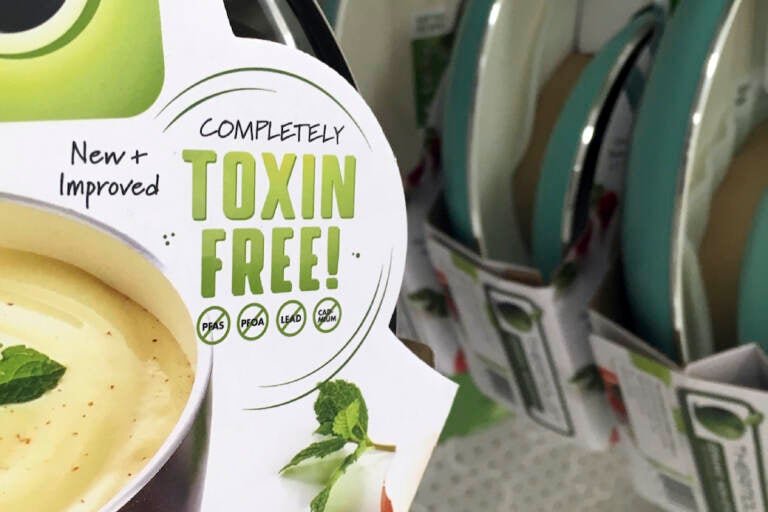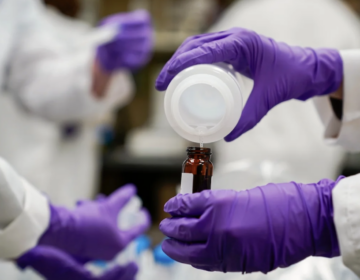EPA to consider expanded list of toxic ‘forever chemicals’ for regulatory plans
PFAS are linked to health impacts, including some cancers, and have shown up in water, soil and air.

In this June 17, 2019, file photo in Washington, a label states that these pans do not contain PFAS, perfluoroalkyl and polyfluoroalkyl substances. (AP Photo/Ellen Knickmeyer, File)
The Environmental Protection Agency took a step this week that could lead to greater oversight of the class of toxic chemicals known as PFAS in drinking water.
For decades, PFAS chemicals have tainted the water, air, and soil in the Philadelphia region and across the country. Manufacturers have used the so-called “forever chemicals” to make water resistant clothes, non-stick pans, and firefighting foam.
Researchers have found them everywhere — in soil, drinking water and even bloodstreams. They are called “forever” because they can last in the environment, and in the human bloodstream, for a long time.
The PFAS compounds, which stand for “per-and polyfluoroalkyl substances,” number in the thousands. Scientists are still studying the impacts of these substances on human health, but the Centers for Disease Control say those exposed have a higher risk for high cholesterol, kidney cancer, testicular cancer, and damage to the immune system. However, PFAS is not federally regulated.
The Safe Drinking Water Act requires the EPA every five years to propose contaminants that could be regulated under what’s known as the Drinking Water Contaminant Candidate List — or, CCL. The agency must take action on at least five of the listed contaminants after a review process.
This year’s list, published Wednesday, includes an expansion of the kinds of PFAS being considered. The announcement comes a year after the EPA released a “roadmap” to address PFAS contamination.
“Following public engagement and robust scientific review, the final contaminant candidate list is the latest milestone in our regulatory efforts to ensure safe, clean drinking water for all communities …Today’s final CCL 5 looks further forward to consider additional protective steps for these forever chemicals,” said EPA Assistant Administrator for Water Radhika Fox in a statement.
Listing a contaminant on the EPA’s CCL doesn’t necessarily result in regulation. In 2009, two types of PFAS contaminants — PFOA and PFOS — were listed, but no regulatory action has been taken.
“The health effects and potential health effects have been known for many years now, and in general, the EPA has been slow to regulate chemicals in drinking water,” said Robert Laumbach, who studies PFAS at Rutgers University. “It’s definitely a step in the right direction and it’s going to require ongoing commitment to go through the regulatory process if it’s ultimately going to lead to a regulation.”
The EPA already sets a federal health advisory level for PFAS in drinking water, however it is non-enforceable. But the agency has recently taken a stronger stance. In June, the EPA reduced the advisory level from 70 parts per trillion to almost zero parts per trillion, after announcing the compounds are more dangerous than previously thought. The agency says it will propose the first nationwide drinking water standards for PFAS by the end of this year.
Tracy Carluccio of the advocacy group Delaware Riverkeeper Network calls the EPA’s decision to expand PFAS in its CCL an “important improvement” and “much needed, since the class of PFAS and substructures [chemicals that can break down into PFAS] is so enormous.”
The definition of PFAS in the EPA’s CCL was expanded thanks to public input, Carluccio said. However, she said it doesn’t come anywhere near protecting people from the 9,000 types of PFAS in existence.
There are some key factors that the EPA considers when regulating a contaminant, Laumbach said.
“It’s the occurrence, the risk, and whether or not regulating the compound would sufficiently reduce the risk — essentially that it’s worth doing that under cost benefit analysis,” he said.
In the absence of current federal regulations some states have enacted their own limits. New Jersey has taken the strongest stance against PFAS contamination in the region. In 2018, the state established enforceable limits for PFAS in drinking water, restricting PFOS and PFNA to 13 parts per trillion and 14 parts per trillion for PFOA.
This year, Pennsylvania and Delaware followed suit. Pennsylvania proposed a limit of 14 parts per trillion for PFOA and 18 parts per trillion for PFOS, while Delaware proposed a limit of 14 parts per trillion for PFOS and 21 parts per trillion for PFOA.
WHYY is your source for fact-based, in-depth journalism and information. As a nonprofit organization, we rely on financial support from readers like you. Please give today.







